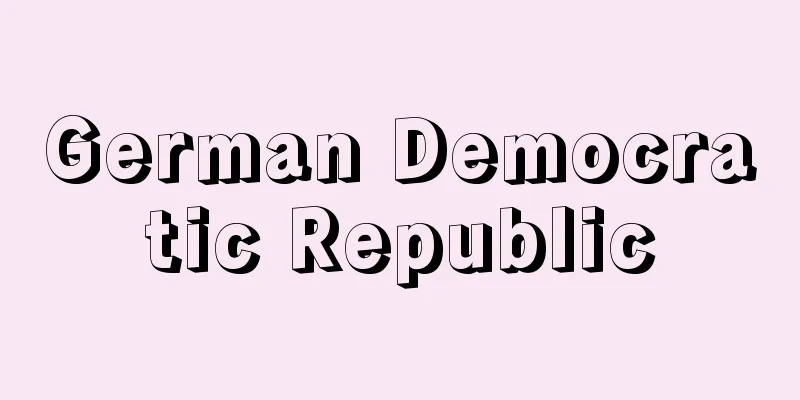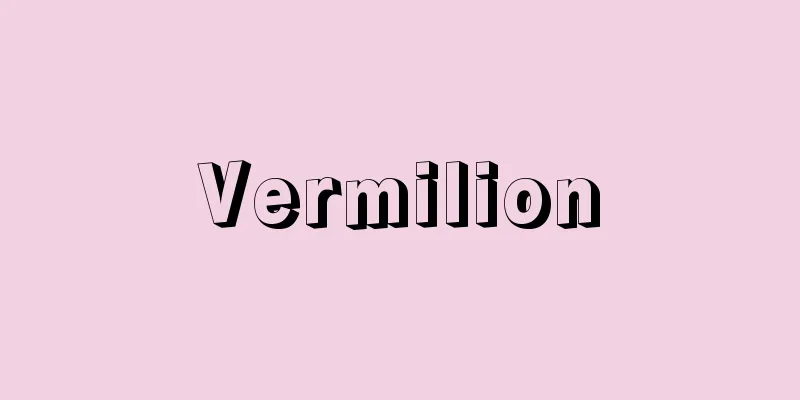German Democratic Republic

|
A republic that existed in the northeastern part of Germany, covering approximately 30% of the area, from 1949 to 1990. It was established on October 7, 1949, based on the area of Germany occupied by the Soviet Union after World War II. Its official name was the German Democratic Republic (Deutsche Demokratische Republik, abbreviated as DDR), and its English name was the German Democratic Republic (abbreviated as GDR). It was also called East Germany. The capital was East Berlin, and the country was divided into 14 districts (bezirks) in addition to Berlin. The area was 108,300 square kilometers, and the population was about 19 million at the time of the country's founding, but there was a large outflow of population to West Germany, and by the end of 1960, it had fallen to 17.19 million. In order to stop this outflow, the Berlin Wall was built in August 1961, which temporarily stopped the outflow, but because the population was aging, the population did not increase after that, and as of the end of June 1988, it was 16.67 million. Since it was established based on the Soviet occupied area, friendly and cooperative relations with the Soviet Union were important, and it joined the Warsaw Pact and COMECON (Council for Mutual Economic Assistance), and belonged to the socialist bloc. In terms of political system, it had a unicameral parliament, and the chairman of the State Council, the power organ of the People's Assembly, was the de facto head of state. Many of the members of the State Council belonged to the Secretariat of the Central Committee of the Socialist Unity Party of Germany (SED), and a socialist course was pursued under the guidance of the SED. In response to the policy of "one nation, two states" of the Federal Republic of Germany (West Germany), Germany advocated "two nations, two states" and in 1973, Germany and West Germany joined the United Nations at the same time, and it seemed that the situation of two Germanys was fixed. In the late 1980s, a trend toward easing East-West tensions began to appear around the world, and the wave of democratization and liberalization especially in Eastern Europe grew. In 1989, Honecker, who had been the chairman of the SED since 1976, was dismissed for being unable to respond to the demand for domestic democratization. In November of the same year, a large rally was held demanding democratization, and the government decided to liberalize emigration and open the borders, and the Berlin Wall was destroyed. In March 1990, the first free elections were held, and the German unification faction won. The unification treaty was then signed on August 31, 1990, and on October 3 of the same year, the two Germanys were unified, and the GDR came to an end. The former East Germany was a region where industrial development was lagging behind, but after the country was founded, an aggressive industrialization policy was implemented, and it became the most industrially advanced country among the former socialist countries of Eastern Europe. However, it was heavily dependent on the Soviet Union for raw materials and energy resources. In agriculture, it was one of the world's leading producers of potatoes, and most of the management structures were state-run or production cooperatives. In what follows, I will discuss the situation in the 1980s during the Cold War, focusing primarily on the politics, economy, and society of East Germany, given the historical significance of the existence of the socialist state. [Noriyoshi Ukita] Politics, Diplomacy, and MilitaryConstitutionThe Constitution of the German Democratic Republic came into force on October 7, 1949. Aiming for a unified German Republic, this constitution proclaimed parliamentary democracy and federalism, popular sovereignty, and the guarantee of fundamental human rights as its political system. It was partially modified over the course of subsequent developments, and was replaced by a new constitution in 1968. The 1968 constitution clearly defined the leading role of the Marxist-Leninist Socialist Unity Party of Germany (hereafter abbreviated as SED), the "vanguard party of the working class," and stated that the German Democratic Republic (hereafter abbreviated as DDR) was a state in which urban and rural workers exercised political power under its leadership. However, this constitution still acknowledged the unity of the German people, touting that the DDR was a "socialist state of the German people," and mentioned the possibility of German reunification in the future. However, in the 1970s, when the DDR began to be widely recognized as a state by the Western world (see the "Diplomacy" section below), the Federal Republic of Germany (West Germany) government advocated the "one nation, two states" theory, which held that the German people were one, but that two states existed side by side. In opposition to this view, the DDR government came to assert the "two nations, two states" theory, which held that the people were now divided into a "capitalist nation" and a "socialist nation". Reflecting this position, the constitution was amended in 1974 to remove the phrase "of the German people...", and the idea of German reunification was also completely rejected. This was a sign of confidence for the DDR, which had been ignored by the Western world as a nation for more than 20 years since its founding, and had joined the United Nations at the same time as the Federal Republic of Germany in 1973, and was now independent. However, after the rapid progress of democratization in 1989 and the removal of the Berlin Wall, the issue of German reunification suddenly emerged. [Yuichi Shimomura] Political structureThe highest organ of state power is the People's Assembly (500 members in total), which is re-elected every five years. The Assembly is responsible not only for enacting laws but also for their implementation. In other words, the principle of separation of legislative, executive and judicial powers is rejected, and instead, the combination of the three powers is emphasized as the realization of "democratic centralism" of power. Therefore, the People's Assembly controls the organs of power exercised by the Council of State, the Council of Ministers, the National Defense Council, the Supreme Court and the Public Prosecutor's Office. The Council of State is responsible for the external representation of the DDR, ratification of treaties, guidance of lower-level people's representative bodies, and the determination and implementation of basic defense policies. Its chairman (Erich Honecker from October 1976 to October 1989, and Manfred Gerlach since December 1989) is the de facto head of state of the DDR. Many of the members of the Council of State also belong to the Secretariat of the Central Committee of the SED, and the state and the SED leadership are closely connected in terms of personnel. The Council of Ministers is the body that oversees each ministry and agency, and is in effect the equivalent of a government. Its 45 members, most of whom are members of the SED, meet once a week. It is chaired by the Prime Minister, and together with several deputies and about 20 cabinet ministers, it is responsible to the People's Assembly. In the free elections for the People's Assembly held in March 1990, following democratization, the conservative German Coalition, led by the Christian Democratic Union, won a landslide victory. In local administration as well, administrative units such as prefectures (becilks) and counties (kreis) were introduced in 1952, rejecting the principles of federalism and local autonomy and adopting a centralized system. [Yuichi Shimomura] Political parties and mass organisationsThe leading party, the Socialist Unity Party of Germany (SED), had approximately 2.2 million members. The party's highest body, the Party Congress, is held every five years, and the next leading body is the Central Committee, which has a Politburo that discusses and decides on basic policies, and a Secretariat that oversees their implementation. Honecker, who became the party's first secretary (later renamed General Secretary) in 1971, presided over the Politburo and oversaw the Secretariat as General Secretary (he was dismissed in October 1989). There were four other parties: the Christian Democratic Union (approximately 120,000), the Liberal Democratic Party (approximately 80,000), the Democratic-Farmers Party (approximately 100,000), and the National Democratic Party (approximately 90,000). Each party sent a representative to the People's Assembly and participated in the State Council and the Council of Ministers, but within the framework of the so-called bloc policy of the "National Front for a Democratic Germany," they recognized the leadership of the SED and shared the role of appealing to all segments of the population (Christians, the urban middle class, farmers, former Nazi supporters, and Wehrmacht soldiers). In the election, voters were asked to vote against the National Front's unified list of candidates. In addition to these political parties, the so-called mass organisations such as the Free German Trade Union Confederation (approximately 9 million members), the Free German Youth (approximately 2.3 million), the German Democratic Women's Union (approximately 1.4 million), and the Cultural Union (approximately 240,000) also sent representatives to the People's Assembly as constituent organisations of the National Front for Democratic Germany, and each had its own parliamentary group. In response to democratisation after 1989, the SED removed its leadership role from its party statutes, and in 1990 changed its name to the Party of Democratic Socialism (PDS). [Yuichi Shimomura] JudiciaryIn principle, trials were heard in the district (kreis) courts as the first instance, with the provincial (becilk) courts acting as higher courts. The Supreme Court had jurisdiction over all courts, including military courts, but the final decision on constitutionality and legality rested with the National Council. Judges and juries were elected by the parliaments at each level or by citizens. In addition, minor illegal acts and disputes in employment relations were heard by company dispute committees or municipal arbitration committees with the direct participation of citizens. [Yuichi Shimomura] DiplomacyRussia advocated proletarian internationalism and made friendship and cooperation with the Soviet Union the cornerstone of its foreign policy. It was integrated into the Commonwealth of Socialist States through COMECON and the Warsaw Pact. It was difficult to develop an independent foreign policy because it was heavily dependent on the Soviet Union for military and industrial raw materials, and because it was in competition with the Federal Republic of Germany. However, it sometimes tried to check Moscow in its relations with the Bonn government and on the issue of nuclear disarmament in Central Europe. In the Third World, it emphasized its position of solidarity with national liberation movements and support for political and economic independence. Until the early 1970s, it actively pursued diplomatic relations with the Third World and non-aligned countries with the aim of establishing diplomatic relations, but after that, it was not very active on the whole. Rather, its diplomatic focus was on improving relations with capitalist countries, including Japan. Its basic policy was to maintain peaceful coexistence based on the current situation in Europe that arose after World War II, especially the fixed division of Germany. In this sense, the 1972 Treaty on Basic Relations between East and West Germany, which was based on the exchange of representatives between the two German states, and the Final Document of the 1975 Conference on Security and Cooperation in Europe (Helsinki Conference), which called for the preservation of Europe's current borders, are considered the foundations of DDR diplomacy with the Western world. The conflict over West Berlin, which had been a source of conflict for a long time after the war, was also tentatively resolved with the signing of the Berlin Four Powers Agreement in 1972. Due to the strong opposition of the Federal Republic of Germany, the exchange of ambassadors with Bonn did not take place, but the DDR was determined to continue to view the Federal Republic as a foreign country. Since the establishment of diplomatic relations with Japan in 1972, there has been exchange, especially in the areas of culture and economy. [Yuichi Shimomura] MilitaryIn 1962, conscription was introduced, and young men, usually aged 18 to 19, served for 18 months in the National People's Army. The National People's Army, consisting of the Army, Navy, Air Force, and 48,000 border guard troops, had a total strength of about 215,000 and was under the control of the Ministry of Defense. In times of emergency, all armed forces, including the People's Police Mobile Units (18,000 troops, permanent garrison units equipped with troop carriers and heavy weapons) under the control of the Ministry of Internal Affairs, and the Workers' Combat Units (350,000 SED members) under the direct control of the Central Committee of the SED, came under the command of the National Defense Council. The National People's Army was also subordinate to the Warsaw Pact Joint Command, which was based in Moscow. The Political Bureau of the Central Committee of the SED had a National Defense Committee, under whose leadership political education and propaganda activities were carried out for soldiers and officers through political commissars and SED party members within the National People's Army, thereby constantly strengthening loyalty to workers' and peasants' power and socialism. [Yuichi Shimomura] Economy and IndustryStructural featuresBefore World War II, the East German economy functioned as an integral part of the economic structure of the former Germany, but after the defeat in 1945, it was divided and forced to manage its economy independently. Moreover, East Germany, which was the main battlefield, was devastated even more than West Germany, and had to restart in an extremely exhausted economic environment under the Soviet occupation. The transportation network had been constructed as an artery connecting the east and west of the former Germany, but at the end of the war, when a link was needed between the north and south, the existing transportation network was hardly useful. The raw materials required for economic reconstruction were scarce and of poor quality, as the region had been primarily agricultural. In addition to the harshness of dismantling and removing damaged existing facilities, the economic burden of war reparations was too heavy, and the East German industrial economy lacked most of the necessary prerequisites. In February 1948, the German Economic Committee (DWK) was established. This was a coordinating body for the basic development of economic planning throughout the Soviet occupation zone, drawing up half-year and two-year plans and laying the foundations for a "socialist planned economy." With the establishment of the German Democratic Republic in 1949 as a turning point, the goal of "ensuring the rapid development of the Republic's productive forces" (restoring destroyed industrial capabilities and reviving potential industrial power) was promoted through a system of centralized planning of economic construction. After that, economic reconstruction was carried out through the First Five-Year Plan (1951-1955), the Second Five-Year Plan (1956-1960), the First Seven-Year Plan (1959-1965), the Third Five-Year Plan (1966-1970) and so on. During that time, the "Berlin Wall" was built in 1961 to prevent the outflow of labor to the West, economic reforms that respected the autonomy of companies were implemented from 1963, and relations with West Germany were normalized in 1972 with the Basic Treaty between East and West Germany, which provided economic support from West Germany and enabled Germany to successfully rebuild its economy and enjoy the most prosperous society in Eastern Europe. In 1979, 30 years after the founding of the country, the country boasted of the fulfillment of its historical experience of a socialist economy and the "remarkable achievements" of its people's democratic economy and industry, and implemented the Sixth Five-Year Plan from 1981 to 1985, and the Seventh Five-Year Plan from 1986 onwards. [Kitamura Jiichi] resourceLignite is Germany's most important mineral resource, with estimated reserves of about 25 billion tons, and was open-cut mined in the Leipzig, Halle and Cottbus regions (1984 production: 296.3 million tons, one-third of the world's total production, ranking first). After unification (2000), Germany now has coal reserves of about 67 billion tons, ranking among the highest in the world, but the majority of production is low-grade lignite. Potash salts are one of the reserves mined in four mining areas in the Werra River basin, the South Harz, the Saale and Unstrut river basins, and the North Harz, and together with those in West Germany, they formed the foundation of German chemistry and were of global importance. However, Germany had small reserves of high-quality coal (mined in Zwickau and Oersnitz in Karl-Marx-Stadt district), iron ore, and non-ferrous metals, and faced serious problems compared to West Germany's resource policy and energy problems. For example, the amount of coal mined was 84,000 tons (1978) and 48,000 tons (1979), less than one-thousandth of West Germany's. Germany had no choice but to depend on lignite for two-thirds of its total energy demand, and energy conservation and efficient use were urgent issues in all sectors of the economy. Other reserves included limestone, chalk, gypsum, clay, china clay, slate, quartz, fluorite, and barite. Among European countries, East Germany ranked highly in terms of the use of water resources, with an annual potential water volume of 18.5 billion cubic meters, an actual usage volume of 7 billion cubic meters, and a utilization rate of 37.8%. If we assume a stable water volume of 9 billion cubic meters and an effective usage volume of 7.7 billion cubic meters, the utilization rate is 86%. Approximately 1.3 billion cubic meters of dams contributed 1.16 billion cubic meters to water utilization and flood protection. [Kitamura Jiichi] Agriculture, forestry and fisheriesThe main goal of the East German agricultural system was the inevitable creation of socialist relations of production. It planned the economy and society centrally and organized operation and management in an orderly way, but political guidance limited the scope of decision-making in agricultural management and restricted management layout and market transactions between management. Thus, agricultural management was understood not only as an economic unit but also as a social unit functioning in socialist planning. Therefore, privately owned agricultural management was almost nonexistent, and production units specialized in a few products, that is, agricultural production cooperatives (LPG Landwirtschaftliche Produktionsgenossenschaft) that institutionalized "cooperation", were the main players in agriculture. There was also people's land, but its proportion was small, and the reorganization and consolidation of LPG led to large-scale and mechanized farming, and in recent years, there has been a desire to rationalize cultivation and form wide-area cooperative connections with the goal of cooperation with the food industry. East Germany's agricultural land (arable land and pasture land) was equivalent to 58% of the country's land area, a higher ratio than West Germany. Potato production was among the world's highest, and in terms of yield per hectare it was second only to the United States. Grain cultivation consisted of barley, wheat, rye, and oats, but the production volume of each was less than West Germany. Other crops grown were sugar beets, oil plants, and feed crops, but in the case of corn, both the planted area and harvest volume were less than 1% of West Germany's. In terms of livestock, East Germany mainly raised cattle and pigs, and each of these animals was about one-third to one-half of that in West Germany. What was different was that East Germany had a far greater number of sheep, 22,500 goats, which were not found in West Germany, and an extremely small number of horses. The 410,000 colonies of honeybees were also noteworthy. East Germany's self-sufficiency in agricultural products was 86 to 83% from 1968 to 1970, but this fell to 76% in 1978 and 70% in 1979. This was due to a series of poor harvests since 1975, but there was an exceptionally good harvest in 1980, which resulted in a 2.5% increase in agricultural production. Thereafter, grain production records were broken in 1984 and 1985. Fisheries activities were carried out by producer cooperatives (PWF) for the joint management and use of fishing equipment in river and lake areas. However, there was no cooperative system for marine and coastal fisheries. Freshwater catches included carp, eel, pike, salmon, trout, and perch. The Baltic Sea fishery had landings of 300,000 tons, roughly the same as in West Germany, and was declining. [Kitamura Jiichi] Mining and ManufacturingThe most important lignite region in East Germany, Niederlausitz, produced 160 million tons per year, a dramatic increase of about 20 times compared to the region's annual production of 7.9 million tons at the beginning of the 20th century. The Schwarze Pump lignite complex in Cottbus and the lignite coke plant in Lauchhammer were world famous for the size and performance of their production facilities and were the mainstays of the country's mining industry. The daily consumption of raw materials and energy in industry is as follows: 700,000 tons of lignite, 21,000 tons of rolled steel, 31,000 tons of cement, 10,000 cubic meters of sawn timber, 52,000 tons of oil, 32 million cubic meters of natural gas, 265 million kilowatt hours of electric energy, and 6 million liters of motor oil (1978). This is the true face of daily production activities in the "people's economy." Based on the consumption of these raw materials, many industrial complexes created their own means of rationalization and improved their productivity. Industrial complexes were formed as "basic economic units of material production," and expanded to 36 in 1970 (33% of industrial production), 45 in 1975 (43%), and 133 in 1980 (99%), playing a major role in promoting industry under central government control. During the process of socialization, industrial enterprises were converted into people's owned enterprises (VEB - Volkseigener Betrieb), and their leading organization, the Union of People's Owned Enterprises (VVB), worked together with the industrial complexes to promote production efficiency. East Germany's industrial region was centered in Berlin and the southern part of the country, with the four major industrial areas being the Berlin area, the Karl-Marx-Stadt (now Chemnitz)-Zwickau area, the Dresden area, and the Halle-Leipzig area. Steelmaking had been carried out in Unterwellenborn on the upper reaches of the Saale River since before World War II, and after the war steelworks were built in Eisenhüttenstadt on the Oder River and Kalbe on the Saale River. Raw materials were supplied by the Soviet Union, Poland, Czechoslovakia, and other countries, and crude steel production was not very high, at 7,573,000 tons (19% of West Germany's in 1984). The mechanical industry was characterized by the production of chemical industry machinery equipment, aviation technology equipment, refrigeration technology equipment, and other heavy machine tools, with Leipzig being its largest center. The VEB also has a long tradition of producing cameras, telescopes, clocks, and other precision machinery, and the famous Carl Zeiss of Jena was founded in 1846 and became a representative company of the VEB after the war. Other notable companies include electrical machinery in Berlin and Dresden, automobiles in Eisenach and Zwickau, and shipbuilding in Rostock. The chemical industry, including pharmaceuticals, fertilizers, and plastics, is also thriving, with a petrochemical complex in Schwett and one of the world's largest chemical complexes in Leuna. Meissen pottery is famous as a traditional industry. In recent years, the city has been proactive in developing and introducing cutting-edge technology, and production volumes of semiconductors, microchips, industrial robots, and other products have increased. This has led to efforts to conserve energy, streamline production, and centralize production, as well as to address resource and labor shortages. [Kitamura Jiichi] Trade and FinanceIn the 1960s, exports and imports were relatively balanced, but in the 1970s, imports continued to exceed exports, and export expansion became a major goal. This trend improved in the 1980s, and in 1984, imports were $22.94 billion and exports were $24.836 billion, resulting in a surplus of $1.896 billion. As a member of COMECON, which includes the Soviet Union and Eastern European countries, it maintained close economic ties with the COMECON countries. Therefore, the main partners for both exports and imports were COMECON member countries, accounting for about two-thirds of exports and imports. Of these, the Soviet Union was the largest partner, accounting for about 38% of total exports and imports (1983). Among capitalist countries, West Germany was the largest (8%). Imports include crude oil as a raw material and textiles as a finished product, while exports include agricultural machinery, tractors, and milling machines. The "German Democratic Republic mark" was a purely domestic currency and was not used as foreign exchange in international transactions. The national central bank determined its exchange rate with the US dollar for commercial and non-commercial transactions, and it was essentially equivalent to the West German mark. The most important sources of the state treasury were consumption taxes, as well as production and work taxes and transaction taxes levied in the "people's ownership economy." [Kitamura Jiichi] trafficGermany's railway network totaled 14,226 kilometers, of which 15% (1983) was electrified, lower than West Germany's, but electrification was being promoted. Germany's inland waterways totaled 2,302 kilometers (1980), and the waterway network was well developed, with a large volume of freight transported. Germany's national highways totaled 13,092 kilometers, of which 12% were autobahns (highways). Germany's air routes were operated by the state-run Interflug, with a total of 60 routes connecting Europe, as well as the Middle East and Asia. Germany's oil pipelines were roughly the same length as those of West Germany, but the amount of crude oil transported was only half and the useful tonne-kilometers only one-third. [Kitamura Jiichi] Development and ConservationThe problem with East Germany's land development was to effectively operate a social fund based on its own technological characteristics within the international division of labor of the COMECON system as an economic strategy in the 1980s. The issues surrounding environmental conservation included the reproduction of natural resources (especially the water economy), the expansion of new "cooperative" relationships, the balance between social production and social consumption, and problems associated with the promotion of industrialization policies such as the automation of industrial production. [Kitamura Jiichi] societyLaborThe Constitution of the German Democratic Republic stipulates that work is both a right and a duty of citizens. The basic position is that work is not only intended to improve the material and cultural production levels of the people through "voluntary and conscious participation in the labor process," but ultimately serves as the driving force for the all-round development of the socialist personality and socialist life. Since the means of production are owned by the people, refusal to work is considered a suicidal act by the workers, and the right to strike is not recognized. The only labor union is the Free German Trade Union Federation, a unified organization of 12 individual industrial units on an industrial basis. As the most important organization for realizing the principle of "work together, plan together, govern together!", the labor union was responsible not only for improving the working and living conditions of workers and workers, but also for planning and implementing plans, increasing labor productivity, and promoting scientific and technological innovation. [Yuichi Shimomura] social securityThere are both union and state-run schemes, but the content is the same, and they offer a wide range of generous benefits, including free medical care, sickness benefits, pregnancy and childbirth benefits, maternity protection, disability and old-age pensions, free medicines, and free medical treatment. The amount of pensions is still inferior to that of the Federal Republic of Germany, but since the early 1970s, there have been improvements in this area as well. Unemployment insurance is no longer necessary in practice, since full employment has been achieved and surplus personnel due to rationalization and other reasons are guaranteed wages and receive vocational training for reemployment. [Yuichi Shimomura] HousingSince the early 1970s, the government of the GDR has made solving the housing problem a key task in its social policy and has been working on it energetically. The plan was to build or renovate 2.8 to 3 million homes between 1976 and 1990, and thus solve the housing problem. Although there were some delays, construction progressed smoothly, and in 1981 the number of housing units per 1,000 inhabitants increased from 327 in 1961 to 393, and the living area per person also increased from 17 square meters to 23 square meters. Although living conditions are still poor compared to the Federal Republic of Germany, rents are very cheap: in 1981, the rent per square meter for a household with a monthly income of 2,000 German marks was 1 to 1.25 marks in Berlin (East) and 0.8 to 0.9 marks in other areas. [Yuichi Shimomura] educationSince 1965, compulsory education has been offered to students from 6 to 16 years of age. The 10-year General Education and Multi-Technical High School, which is responsible for this, is divided into beginner (4 years), intermediate (3 years), and advanced (3 years). At the beginner level, most of the class time is devoted to German and mathematics, while at the intermediate level and above, the emphasis is on Russian and science and technology. The goal is to develop a complete personality, and as a means to achieve this, a close connection between productive work and education was advocated, based on Marx's argument. In particular, technical education linked to career choices was given a large weight in the advanced years. After completing the 10th grade, students can choose from three paths: (1) get a job after two years of vocational training, (2) go on to a technical school for three or four years, or (3) go on to a university after a two-year university preparatory course. There were 233 vocational schools, mainly in the fields of science and engineering, medicine, and education, and a total of 53 universities, including six comprehensive universities (1986). There were approximately 100,000 students enrolled in university courses, with another 30,000 taking night and correspondence courses. The rate of students going on to university was not high. The principle of equal educational opportunities was placed on the ground, with no education fees being made from beginners to universities, and at the same time, early gifted education was also thoroughly implemented. [Shimomura Yuichi] Women and homeEqual rights for men and women are one of the basic principles of socialism, and in this country, women are prominently entering the workplace, thanks to the labor shortage. More than 49% of the number of employees were women, with just under 83% of women of employment working. Moreover, more and more women were found to be leading positions in all sectors, including industrial, commercial, transportation and services. As women's economic independence progresses this way, it appears to be an important cause of the increase in divorce. The divorce rate continued to increase year by year, and by the 1980s it reached just under 30 against the population of 10,000, far exceeding that of the Federal Republic of Germany. The high rate of divorce among young people and at the same time, is characteristic of the high rate of remarriage. As a result, despite the efforts of the government and the party, which place importance on families as a "basic community" to "harmony between social requests and basic personal interests," the collapse of families and its implications for children have also led to various issues. With the enhancement and completeness of daycare centers and daycare centers, efforts to encourage women to advance into society, and their position of trying to preach the importance of love between husband and child and parents and children, and to maintain the family as the basis of social order cannot be easily found. [Shimomura Yuichi] crimeになったんです。 English: The first thing you can do is to find the best one to do. [Shimomura Yuichi] culture
[Shimomura Yuichi] Relations with Japan
[Noriyoshi Ukita] "The Process of Development of German Socialism" (1969, Minerva Shobo) " (1969, Minerva Shobo)" (Kinshusho, "The Structure of the East German Economy" (1973, Minerva Shobo) " (1973, Minerva Shobo)" (Saito Mitsukazu, East Germany (edited by Kiuchi Shinzo, World Geography 8, Europe III, 1977, Asakura Shoten)" (L. Bath, translated by Ukita Noriyoshi, East Germany: Its Land and People's (Completely Translated by the World Geography Textbook Series 9, 1978, Teikoku Shoin)" (English: The German Democratic Republic and Polish People's Republic edited by the East European Division of the Ministry of Foreign Affairs (General Countries, the Soviet Union, Eastern Europe Edition, 1984, Japan Institute of International Studies) " (JETRO Trade Market Series 246, East Germany (1984, Japan External Trade Association)" (1984, Japan External Trade Association)" (1984, Overseas Business Guide Edited by Ogawa Kazuo, "Overseas Business Guide Edited by Ogawa Kazuo "Soviet and Eastern Europe" (1986, Japan External Trade Association)" ▽ "H. Weber, translated by Saito Tetsu and Hoshino Hajime", "History of the German Democratic Republic" (1991, Nihon Keizai Hyoronsha)" ▽ "Sumitani Kazuhiko et al., "Unification of Germany and the Transformation of Eastern Europe" (1992, Minerva Shobo)" ▽ "Kobayashi Koji, "Light and Shadow of Integrated Germany" (1993, Ninomiya Shoten)" ▽ "Onishi Takeo and U. Rins, "Integration of Germany" (1999, Waseda University Press)" ▽ "Kobayashi Koji et al., "Central Europe after the Eastern European Revolution" (2000, Ninomiya Shoten)" ▽ "Hirono Hiroshi, "The Legendary Country: East Germany" (2002, Gendai Shoten)" [Reference Item] | | | | | | |Source: Shogakukan Encyclopedia Nipponica About Encyclopedia Nipponica Information | Legend |
|
ドイツの北東部、面積にしてほぼ3割の地域に、1949年から1990年まで存在した共和国。第二次世界大戦後のドイツのソ連占領地区をもとに1949年10月7日に樹立された。正式名称はドイツ民主共和国Deutsche Demokratische Republik、略称DDR、英語名はGerman Democratic Republic、略称GDR。東ドイツともよばれた。 首都は東ベルリンに置かれ、国土はベルリンのほかに、14の県(ベツィルク)に分かれていた。面積は10万8300平方キロメートル、人口は建国当時約1900万人であったが、その後、西ドイツへの人口流出が激しく、1960年末には1719万人に減っていた。この人口流出を阻止するために、1961年8月にベルリンの「壁」が構築されたのであり、それにより人口流出はいちおう治まったが、人口構成が高齢化していたため、その後も人口は増えず、1988年6月末の人口は1667万人であった。 ソ連占領地区をもとにして成立したため、ソ連との友好・協力関係が重視され、ワルシャワ条約機構、COMECON(コメコン)(経済相互援助会議)に加盟し、社会主義圏に属していた。政治体制としては、一院制の議会をもち、その人民議会の権力機関である国家評議会の議長が事実上の元首となっていた。国家評議会の構成員の多くはドイツ社会主義統一党(SED)の中央委員会書記局に属し、SEDの指導のもと、社会主義路線が進められていた。 ドイツ連邦共和国(西ドイツ)の「一国民二国家」の方針に対し、「二国民二国家」を主張、1973年には西ドイツとともに国連への同時加盟を果たし、二国家のドイツという状況が固定されるように思われた。1980年代後半に入ってから、世界全般に東西緊張緩和の流れが生じ、とりわけ東欧において民主化・自由化の波が高まった。さらに1989年に入ると、1976年以来SED議長を努めていたホーネッカーが、国内民主化の要求に対応できず、解任された。同年11月には民主化要求の大集会が開かれ、政府は出国の自由化、国境の開放を決定、ベルリンの壁が消滅した。1990年3月に初の自由選挙が行われ、ドイツ統一派が勝利を収め、ついで1990年8月31日に統一条約に調印、同年10月3日、両ドイツが統一され、ドイツ民主共和国はその幕を閉じた。 旧東ドイツの地域は、工業発展の遅れた地域であったが、建国後、積極的な工業化政策が進められ、東ヨーロッパの旧社会主義諸国のうちでは工業のもっとも進んだ国であった。ただし、原材料・エネルギー資源はソ連に大きく依存していた。農業ではジャガイモの生産量が世界上位に位置し、経営形態としては、国営および生産共同組合がほとんどを占めていた。 以下は、社会主義国家東ドイツが存在した歴史的意義から、おもにその政治、経済、社会を中心に、冷戦時代の1980年代の状況について述べることにする。 [浮田典良] 政治・外交・軍事憲法ドイツ民主共和国憲法は、1949年10月7日に発効した。単一のドイツ共和国を目ざし、政治体制としては議会制民主主義と連邦制、人民主権、基本的人権の保障をうたうこの憲法は、その後の発展のなかで部分的に改変され、1968年には新憲法にとってかわられた。1968年憲法は、マルクス・レーニン主義政党であるドイツ社会主義統一党(以下SEDと略称)、すなわち「労働者階級の前衛党」の指導的役割を明確に規定し、その指導のもとに都市と農村の勤労者が政治権力を行使する国家がドイツ民主共和国(以下DDRと略称)であるとした。しかしこの憲法は、DDRは「ドイツ国民の社会主義国家」であるとうたって、なおドイツ国民の一体性を認め、将来ドイツが再統一される可能性にも言及していた。ところが1970年代になって、DDRが広く西側世界からも国家として承認されるようになると(後述の「外交」の項を参照)、ドイツ連邦共和国(西ドイツ)政府の唱える「一国民二国家」説、すなわちドイツ国民としては一体であるが、そのなかに二つの国家が並存しているとの見方に対抗して、DDRの政府は、いまや国民としても「資本主義的国民」と「社会主義的国民」に分裂したのだとの「二国民二国家」説を主張するに至った。この立場を反映させて、1974年、憲法が改正され、「ドイツ国民の……」という表現が削除されるとともに、ドイツ再統一の理念も完全に否定されてしまった。これは、建国以来20年以上も国家として西側世界から無視されてきたDDRが、1973年ドイツ連邦共和国とともに国連への同時加盟を果たし、ひとり立ちしたことの自信の表れであった。しかし、1989年の民主化の急進展と、ベルリンの壁撤去以後、ドイツ再統一問題が急浮上してくる。 [下村由一] 政治機構国家の最高の権力機関は人民議会(議員総数500名)で、5年ごとに改選される。議会は法律の制定だけではなくその実施にも責任をもつ。すなわち立法権、行政権、司法権の分立という原則は否定され、むしろ三権の結合が権力の「民主集中制」の実現として重視される。したがって人民議会は権力行使の機関である国家評議会、閣僚評議会、国防評議会、最高裁判所、検察庁を統轄する。国家評議会は、DDRの対外的代表、条約の批准、下級の人民代表機関の指導、国防上の基本方針の決定と実施などにあたり、その議長(1976年10月~1989年10月までエーリヒ・ホーネッカー、1989年12月以降はマンフレート・ゲアラッハが代行)はDDRの事実上の元首である。国家評議会の構成員の多くは同時にSED中央委員会書記局に属し、国家とSEDの指導部は人的にも密接に結合している。閣僚評議会は各省庁を統轄する機関で、事実上、政府に相当する。45名の構成員の多くはSED党員で、毎週1回協議する。その議長は首相であり、数名の議長代理、二十数名の閣僚とともに人民議会に対して責任を負う。なお、1990年3月に行われた民主化に基づく人民議会の自由選挙では、キリスト教民主同盟を中心とする保守系のドイツ連合が大勝した。 地方行政においても、1952年に県(ベツィルク)、郡(クライス)という行政単位が導入され、連邦制、地方自治の原則は否定され、中央集権制がとられていた。 [下村由一] 政党・大衆団体指導政党であるドイツ社会主義統一党(SED)は党員数約220万を数えた。党の最高機関の党大会は5年ごとに開かれ、これに次ぐ党の指導機関である中央委員会は、基本方針を討議決定する政治局と、その実施を指導する書記局をもつ。1971年党第一書記(後に書記長と改称)となったホーネッカーは書記長として政治局を主宰し書記局を統轄した(1989年10月解任)。ほかにキリスト教民主同盟(約12万)、自由民主党(約8万)、民主農民党(約10万)、国民民主党(約9万)の4政党があった。いずれの政党もそれぞれ人民議会に代表を送り、国家評議会、閣僚評議会にも加わっているが、「民主ドイツ国民戦線」によるいわゆるブロック政策の枠内で、SEDの指導権を承認しつつ、国民各層(キリスト教徒、都市中間層、農民、もとナチス支持者、国防軍軍人)に対し働きかける役割を分担していた。選挙では国民戦線の統一候補者リストに対する賛否が問われた。 これら政党のほかに、自由ドイツ労働総同盟(組織人員約900万)、自由ドイツ青年団(約230万)、ドイツ民主婦人同盟(約140万)、文化同盟(約24万)のいわゆる大衆団体も民主ドイツ国民戦線の構成団体として人民議会に代表を送り、それぞれ独自の議員団をもっていた。1989年以降の民主化に対応して、SEDは指導的役割を党規約から削除し、1990年党名を民主社会党(PDS)と変更した。 [下村由一] 司法裁判は、原則として郡(クライス)ごとの裁判所での審理を第一審とし、県(ベツィルク)裁判所が上級裁判所となる。最高裁判所は、軍裁判所を含むすべての裁判所を統轄するが、合憲性、適法性の最終的判断は国家評議会にゆだねられる。判事、陪審は各級議会または市民により選出される。このほか、軽微な違法行為、雇用関係における争いなどは、企業内の紛争委員会または市町村の仲裁委員会において、市民の直接参加により審理された。 [下村由一] 外交プロレタリア国際主義を標榜(ひょうぼう)して、ソ連との友好・協力を外交政策の「礎石」とする。COMECON(コメコン)とワルシャワ条約機構を通じて「社会主義国家共同体」に統合されていた。軍事面、工業原料面でソ連に依存するところが大であり、ドイツ連邦共和国との対抗ということもあって、独自の外交政策を展開することは困難であるが、ボン政府との関係、中部ヨーロッパにおける核軍縮の問題などでは、ときにモスクワを牽制(けんせい)する動きもみられた。第三世界に対しては民族解放運動との連帯、政治的・経済的独立への支援という立場を強調した。1970年代初頭までは国交樹立を目ざしての積極的な外交を第三世界、非同盟諸国に対して展開したが、その後は全体として独自の動きはあまり活発ではなかった。むしろ外交の力点は日本を含む資本主義諸国との関係改善に向けられていた。その基本方針は、第二次世界大戦後に生じたヨーロッパの現状、とりわけドイツ分割の固定化を前提とした平和共存の維持である。その意味で、1972年両ドイツ国家間における代表交換を軸とした「東西両ドイツ基本条約」、およびヨーロッパの現在の国境保全をうたった1975年ヨーロッパ安全保障協力会議(ヘルシンキ会議)の最終文書が、対西側世界のDDR外交の基礎とみなされている。戦後長らく紛争の種であった西ベルリンをめぐる対立も、1972年調印のベルリン四大国協定でいちおうの決着をみた。ドイツ連邦共和国の強硬な反対で、ボンとは大使の交換という形をとるに至っていなかったが、DDRは連邦共和国をあくまで外国とみなそうとしていた。日本とは1972年(昭和47)に国交が樹立されて以来、とくに文化、経済の面での交流があった。 [下村由一] 軍事1962年に徴兵制が導入され、通例18歳から19歳の青年が国民人民軍で18か月間兵役に服した。国民人民軍は、陸海空3軍のほか国境警備部隊4万8000をあわせて総兵力約21万5000で、国防省が統轄するが、非常時には、内務省の統轄する人民警察機動部隊(兵員輸送車、重火器をもつ常時駐屯部隊で兵力1万8000)とSED中央委員会に直属する労働者戦闘班(35万のSED党員により編成される)を含むすべての武装部隊が、国防評議会の指揮下に置かれた。また国民人民軍はワルシャワ条約機構統合司令部に下属しており、統合司令部はモスクワにあった。 SED中央委員会政治局には国防委員会があり、その指導のもとに国民人民軍内の政治委員とSED党員を通じて兵士・将校の政治教育、啓蒙(けいもう)宣伝活動が行われ、これにより労働者・農民権力と社会主義に対する忠誠の強化が絶えず図られていた。 [下村由一] 経済・産業構造的特徴第二次世界大戦前は旧ドイツの経済構造のなかで一体的に機能していた東ドイツ経済は、1945年の敗戦に至って分割され、独自の経済運営を余儀なくされた。しかも主戦場となった東ドイツは西ドイツ以上に荒廃が激しく、ソ連の占領治下にきわめて疲弊した経済環境のなかで再出発をしなければならなかった。交通網も、旧ドイツの東西を結ぶ動脈として建設されていたものであったため、終戦当時、南北方向の組合せを必要とするに至って、既存の交通網はほとんど有用でなかった。経済再建に要する原料資源は、従来主として農業地域であったために乏しく劣悪で、被害を受けた既存設備の解体撤去の過酷さに加え、戦時賠償による経済的負担の過重さのため、東ドイツの工業経済はその必要な前提条件をほとんど欠いていた。 1948年2月「ドイツ経済委員会」DWKが創設された。これはソ連占領地帯全域の経済計画化の基礎的発展を図るための調整機関で、半か年計画、二か年計画を立案し、「社会主義的計画経済」に対する基礎を据えるものであった。1949年ドイツ民主共和国の成立を画期として、中央集権的な経済建設を計画化するシステムを通して、「共和国の生産諸力の急速な発展の保証」(破壊された産業諸能力の復旧と潜在工業力の再興)が推進された。以後、第一次五か年計画(1951~1955)、第二次五か年計画(1956~1960)、第一次七か年計画(1959~1965)、第三次五か年計画(1966~1970)……を経て経済再建が進められた。その間、1961年に「ベルリンの壁」を構築して労働力の西側流出を防ぎ、1963年から企業の自主性を尊重した経済改革を実施、さらに1972年の東西両ドイツ基本条約で西ドイツとの関係が正常化されたことにより西ドイツの経済的支援が得られ、東欧一の豊かな社会を謳歌(おうか)する経済再建に成功した。建国30年の1979年には社会主義経済の歴史的経験の充実と、人民民主主義的経済・産業の「注目すべき成果」を誇示するに至り、1981~1985年には第六次五か年計画、1986年以降第七次五か年計画が進められた。 [北村次一] 資源褐炭は推定埋蔵量約250億トン、もっとも重要な鉱物資源で、ライプツィヒ、ハレ、コットブス地方において露天掘りされていた(1984年、産出量2億9630万トン、世界総生産の3分の1、第1位)。統一後の現在(2000年)、ドイツの石炭埋蔵量は約670億トンと世界でも上位であるが、生産量の大半を低品位の褐炭が占める。カリ塩はウェラ川流域、南ハルツ、ザーレ川およびウンシュトルト川流域、北ハルツの4鉱区で採掘される埋蔵資源の一つで、西ドイツのそれとともにドイツ化学の基盤をなし、世界的意義をもっていた。 しかし高品位の石炭(カール・マルクス・シュタット県のツウィッカウとエルスニッツで採炭)、鉄鉱、非鉄金属は埋蔵量が少なく、西ドイツの資源政策・エネルギー問題に比して深刻な課題を抱えていた。たとえば採炭量は8万4000トン(1978)、4万8000トン(1979)で、西ドイツの1000分の1以下にすぎない。全エネルギー需要量の3分の2を褐炭に依存せざるをえず、エネルギー節約と効率的利用は全経済分野での緊要な課題であった。その他の埋蔵資源として、石灰石、チョーク、石膏(せっこう)、粘土、陶土、スレート、石英、蛍石(ほたるいし)、重晶石があった。 ヨーロッパ諸国のなかで東ドイツは水資源の利用度が高位にあり、潜在的水量は年間185億立方メートル、利用量70億立方メートル、利用率37.8%であった。安定的水量を90億立方メートル、実効利用量を77億立方メートルとして算定すれば86%となる。約13億立方メートルのダムにより、11.6億立方メートルが水利・洪水保全に役だっていた。 [北村次一] 農林・水産業東ドイツの農業制度の主要目標は社会主義的生産関係の必然的な創成である。それは経済と社会を中央集権的に計画化し、運営と管理の秩序ある組織化を行うものであるが、政治的指導によって、農業経営における意思決定の範囲を限定し、経営的配置や経営間市場取引を制約することになる。したがって農業経営は、単に経済的単位としてのみならず、社会主義的計画に機能する社会的単位として理解される。したがって私的所有形態の農業経営はほとんどみられず、少数の生産物に特化(専門化)された生産単位、つまり「協同」を制度化した農業生産協同組合(LPG Landwirtschaftliche Produktionsgenossenschaft)が、農業の主要な担い手であった。ほかに人民所有地があるが、その割合は少なく、LPGの整理・統合により大規模化、機械化が図られ、近時、さらに栽培の合理化と、食品工業部門との提携を目標とした広域的な協同結合が志向されていた。 東ドイツの農業用地(耕地、牧草地)は国土面積の58%に相当し、西ドイツよりも高い比率にあった。ジャガイモ生産は世界の上位にあり、1ヘクタール当りの収量からいえばアメリカに次ぐ。穀物栽培は大麦、小麦、ライ麦、エンバクであるが、生産量はいずれも西ドイツより少なかった。ほかにテンサイ、採油植物、飼料作物を産するが、トウモロコシの場合、作付面積・収穫量ともに西ドイツの1%以下であった。 牧畜では、ウシ・ブタを中心にそれぞれ西ドイツの3分の1ないし2分の1程度の飼育を行っていた。異なるのはヒツジがはるかに多く、西ドイツにはないヤギが2万2500頭おり、ウマがきわめて少数なことである。ミツバチ41万群も特記される。東ドイツの農産物自給度は1968~1970年に86ないし83%であったのが、1978年には76%、1979年には70%と低下している。1975年以来、不作が継続したためであるが、1980年は著しく豊作で、農業生産2.5%増という成果を得ている。以後、1984、1985年とも穀物生産の記録を更新している。 水産活動は、河川湖沼域では漁労手段の協同管理と共同利用のため、生産協同組合就労漁業者(PWF)によって行われた。しかし海域・沿岸漁業では協同組合の制度はなかった。淡水漁獲にはコイ、ウナギ、パイク、サケ・マス、ペルカ(スズキ)などがあった。バルト海漁業では30万トンの水揚げがあり、西ドイツとほぼ同量で、低減しつつあった。 [北村次一] 鉱工業東ドイツでもっとも重要な褐炭地帯であるニーダーラウジッツでは、年間1億6000万トンを採掘していた。この数字を20世紀初頭の同地帯の年産量790万トンと比べると、約20倍という飛躍的な上昇を示している。コットブスのシュワルツェ・ポンプ褐炭コンビナートおよびラウフハマーの褐炭コークス製造工場は、製造設備の規模と成果によって世界的な話題を供しており、同国鉱山業の主柱となっていた。 工業における1日当りの原料・エネルギー消費をみると、以下のとおりである。すなわち、褐炭70万トン、圧延鋼2万1000トン、セメント3万1000トン、挽(ひ)き材1万立方メートル、石油5万2000トン、天然ガス3200万立方メートル、これに電力エネルギー2億6500万キロワット時、モーター油600万リットル(1978)。これが「人民経済」の1日の生産活動の素顔である。これらの原料資源の消費に基づき、多くのコンビナート経営においてそれぞれ独自の合理化手段を創出しながら、その生産性を向上させていた。コンビナートは、「物質的生産の基礎的な経済単位」として形成され、1970年に36か所(工業生産の33%)、1975年に45か所(43%)、1980年に133か所(99%)に発展し、政府の中央管理による工業の推進に大きな役割を果たしていた。また工業企業は社会主義化の過程で人民所有企業(VEB Volkseigener Betrieb)に切り換えられたが、その指導的機関である人民所有企業連合(VVB)がコンビナートとともに生産の効率化を推進していた。 東ドイツの工業地域はベルリンと国土の南部に中心があり、ベルリン地域、カール・マルクス・シュタット(現ケムニッツ)‐ツウィッカウ地域、ドレスデン地域、ハレ‐ライプツィヒ地域が4大工業地帯となっていた。製鉄は第二次世界大戦前からザーレ川上流のウンターウェレンボルンで行われてきたが、戦後これに加えてオーデル河畔のアイゼンヒュッテンシュタットとザーレ河畔のカルベに製鉄所が建設された。原料の供給をソ連、ポーランド、チェコスロバキアなどに仰いでおり、粗鋼の生産量は757万3000トン(西ドイツの19%、1984)で、さほど多くなかった。機械工業は化学工業用機械設備、航空技術設備、冷凍技術設備その他の工作用重機械などの生産に特色があり、その最大の中心地はライプツィヒである。カメラ、望遠鏡、時計などの光学・精密機械工業も伝統があり、有名なイエナのカール・ツァイス社は1846年の創業であるが、戦後VEBの代表的企業となっていた。ほかにベルリン、ドレスデンの電気機械、アイゼナハやツウィッカウの自動車、ロストックの造船などが知られた。 薬品、肥料、プラスチックなどの化学工業も盛んで、シュウェットには石油化学コンビナートがあり、ロイナの化学コンビナートは世界屈指の規模である。伝統産業ではマイセンの陶器が有名である。近年は先端技術の開発・導入にも積極的で、半導体、マイクロチップ、産業用ロボットなどの生産量は増加していた。これにより省エネルギーと合理化、生産の集約化を図り、資源・労働力不足にも対処しようとしていた。 [北村次一] 貿易・財政1960年代には比較的均衡のとれていた輸出入が、1970年代に入って輸入超過を続け、輸出拡大が大きな目標となった。この傾向は1980年代に入って改善をみせ、1984年には輸入229億4000万ドル、輸出248億3600万ドルで18億9600万ドルの黒字となった。ソ連・東欧圏諸国をメンバーとするCOMECON(コメコン)の加盟国で、COMECON諸国と密接な経済関係を保っていた。したがって輸出入とも相手国はCOMECON加盟諸国が主で、輸出入の約3分の2を占める。そのうちソ連が輸出入総額の約38%(1983)で、最大の相手国である。資本主義国では西ドイツが最大である(8%)。輸入商品は原料品では原油、既製品では繊維類が重要であり、輸出商品は農業用機械、トラクター、フライス盤が注目される。「ドイツ民主共和国マルク」は純粋の国内通貨で、外国為替(かわせ)として国際取引においては取り扱われていなかった。国立の中央銀行によって商事・非商事取引に伴う米ドルとの交換比率が決められており、また西ドイツ・マルクとは原則として等価であった。国庫のもっとも重要な源泉は消費税、および「人民所有経済」において徴収される生産・勤務税、取引税などである。 [北村次一] 交通鉄道の延長は1万4226キロメートル、うち電化率は15%(1983)と西ドイツより低いが、電化が推進されていた。内陸水路は2302キロメートル(1980)で、水路網が発達し、その貨物輸送量も多い。国道は延長1万3092キロメートルで、うちアウトバーン(高速道路)が12%である。航空路は国営のインターフルークが就航しており、ヨーロッパ各国はもちろん、中東・アジアなどにも、あわせて60路線が運行されていた。石油パイプラインは西ドイツとほぼ同長の施設をもっていたが、輸送原油量は2分の1、有効トンキロは3分の1にすぎない。 [北村次一] 開発と保全東ドイツ国土開発の問題性は、1980年代の経済戦略として、COMECON体制の国際的分業のなかで、独自の技術的特質に基づく社会的ファンド(基金)を有効に稼動させることにあった。自然資源(とくに水利経済)の再生産、新しい「協同」関係の拡充、社会的生産と社会的消費のバランス、工業生産のオートメーション化のような工業化政策の推進に伴う問題などが、環境保全のうえでの課題となっていた。 [北村次一] 社会労働ドイツ民主共和国憲法は、労働を市民の権利であり同時に義務であるとも規定する。「労働過程への自発的・意識的参加」を通じて人民の物質的・文化的生産水準の向上を図るというだけでなく、究極的には社会主義的人格と社会主義的生活の全面的な発展を進める原動力となるのが労働であるというのが、基本的な立場である。生産手段が人民の所有である以上、労働拒否は勤労者の自殺行為とみなされ、ストライキ権は認められていない。産業別原則による12の個別単産の統一組織である自由ドイツ労働組合同盟がただ一つの労働組合である。労働組合は「ともに働き、ともに計画し、ともに統治せよ!」との原則を実現するための最重要の組織として、労働者、勤労者の労働・生活条件の向上を図るだけでなく、計画作成とその実施、労働生産性の高度化、科学・技術革新の推進などについても責任を負っていた。 [下村由一] 社会保障労働組合によるものと国家によるものとがあるが内容は同じで、無料の医療、疾病手当、妊娠・出産手当、母性保護、障害および老齢年金、医薬品の無料投与、無料の療養など幅広く手厚い給付が行われていた。年金の額などではドイツ連邦共和国に比べてなお劣る面もあるが、1970年代初頭以来この点でも改善が進みつつあった。失業保険は、完全雇用が実現しており、また合理化その他による余剰人員は賃金を保障されたうえで再雇用のための職業訓練が行われるので、実際上必要がない。 [下村由一] 住宅1970年代初頭以来、ドイツ民主共和国政府は住宅問題の解決をその社会政策の重点課題として掲げ、これに精力的に取り組んでいた。計画では1976年から1990年までの間に280万ないし300万戸の住宅を新築または改築し、これにより住宅問題を解決しようというのである。多少の立ち後れはあるものの、いちおう順調に建設は進み、1981年には人口1000人当りの住宅戸数は、1961年の327戸から393戸に増加し、1人当りの居住面積も17平方メートルから23平方メートルに増えた。ドイツ連邦共和国に比べれば、なお居住条件は悪いが、他方、家賃は非常に安く、1981年における月収2000ドイツ・マルクの家計の1平方メートル当りの家賃は、ベルリン(東)で1マルクから1.25マルク、他の地域では0.8ないし0.9マルクであった。 [下村由一] 教育1965年以降6歳から16歳までの義務教育が行われていた。これを担当する「10年級・一般教養・多面技術高等学校」は、初級(4年)、中級(3年)、上級(3年)に分かれる。初級ではドイツ語と数学に大半の授業時間があてられ、中級以降ではロシア語と理工系の教科に重点が置かれていた。全面的な人間形成が目標とされ、その実現の手段として、マルクスの主張に基づき、生産的労働と教育との密接な結合がうたわれた。とくに上級の学年では職業選択と結び付いた技術教育が大きな比重を占めていた。10学年修了後、進む道はほぼ三つに分かれる。(1)2年の職業訓練を受け就職、(2)3~4年の専門学校へ進学、(3)2年の大学進学課程を経て大学へ進学、である。専門学校は理工系、医学、教育を中心に233校あり、また大学は総合大学6校を含め計53校あった(1986)。大学生は、約10万の学生のほか、夜間・通信教育課程に約3万を数えた。大学への進学率は高くない。 初級から大学を通じて教育費はいっさい無料というように、教育の機会均等の原則が重視されると同時に、他方また早期英才教育も徹底して行われていた。 [下村由一] 女性・家庭男女同権は社会主義の基本理念の一つであり、またこの国では労働力不足という事情も手伝って、女性の職場への進出は著しい。雇用者数の49%以上が女性であり、就業可能年齢の女性の83%弱が働いていた。しかも工業、商業、運輸・サービス業などあらゆる部門で指導的な地位にますます多くの女性がみられた。女性の経済的な自立がこのように進むと、それはまた離婚の増加の一つの重要な原因にもなってくるようである。離婚率は年々増え続け、1980年代には人口1万に対して30弱にまで達し、ドイツ連邦共和国のそれをはるかに上回っていた。とくに若年層の離婚率の高さと、また同時に再婚率の高さが特徴的である。 この結果、家庭を「社会的要請と基本的な個人的利害の調和」を図るための「基本共同体」として重視する政府と党の努力とは裏腹に、家庭の崩壊と子供へのそのしわ寄せがさまざまな問題を生むことにもなった。託児所、保育園の充実・完備により、女性の社会的進出を促す努力と、夫婦・親子の愛のたいせつさを説き社会秩序の基礎としての家庭の維持を図ろうとする立場とは、容易には一致点をみいだせないといえよう。 [下村由一] 犯罪犯罪の発生率は、社会生活の安定、生活水準の上昇とともに全体としては低下しつつあったとはいえ、1970年代末から1980年代にかけてわずかながら増加の傾向をみせている。とくに盗み、しかも「社会主義的所有」の盗みよりも「個人的所有」の盗みが一時よりも増加し始めていた。消費生活の一定の豊かさゆえの新傾向であろう。交通犯罪とくに飲酒運転、無免許運転などは減少している。青少年犯罪とくに暴力、傷害事件、とりわけ酒に酔っての事件は多く、かならずしも減少してはいない。16歳から18歳にかけての年齢層で犯罪発生率が最高であり、犯罪の低年齢下が深刻な問題となっていることを物語っている。殺人などの凶悪犯罪は少ないようではあるものの、政治犯罪に関する公式統計はいっさい公表されておらず、また全体として犯罪に関する公式統計は数字に粉飾があるようで、かならずしも全面的には信頼できない。 [下村由一] 文化
[下村由一] 日本との関係
[浮田典良] 『上林貞治郎編『ドイツ社会主義の発展過程』(1969・ミネルヴァ書房)』▽『金錘碩著『東ドイツ経済の構造』(1973・ミネルヴァ書房)』▽『齋藤光格著『東ドイツ』(木内信藏編『世界地理8 ヨーロッパⅢ』1977・朝倉書店)』▽『L・バース著、浮田典良訳『東ドイツ――その国土と人々』(『全訳世界の地理教科書シリーズ9』1978・帝国書院)』▽『外務省欧亜局東欧課編『ドイツ民主共和国・ポーランド人民共和国』(世界各国便覧叢書〔ソ連・東欧編〕・1984・日本国際問題研究所)』▽『『JETRO貿易市場シリーズ246 東独』(1984・日本貿易振興会)』▽『小川和男編著『海外ビジネスガイド ソ連・東欧』(1986・日本貿易振興会)』▽『H・ヴェーバー著、斎藤哲、星乃治彦訳『ドイツ民主共和国史』(1991・日本経済評論社)』▽『住谷一彦他編『ドイツ統一と東欧変革』(1992・ミネルヴァ書房)』▽『小林浩二著『統合ドイツの光と影』(1993・二宮書店)』▽『大西健夫、U・リンス編『ドイツの統合』(1999・早稲田大学出版部)』▽『小林浩二他編著『東欧革命後の中央ヨーロッパ』(2000・二宮書店)』▽『平野洋著『伝説となった国・東ドイツ』(2002・現代書館)』 [参照項目] | | | | | | |出典 小学館 日本大百科全書(ニッポニカ)日本大百科全書(ニッポニカ)について 情報 | 凡例 |
<<: Germany Year Zero - German Reinen
Recommend
Marr, W. (English spelling) MarrW
...and it quickly spread to other European langua...
Squid cage fishing - Squid cage fishing
...These fishing methods are mainly applied to oc...
Ornithosis
...The causative bacteria was previously consider...
Kyoto University Faculty of Liberal Arts Campus Ruins - Kyoto University Faculty of Liberal Arts Campus Ruins
...In recent years, foundry ruins have been disco...
Knoll, M.
...a device that uses electrons instead of light ...
Baltic Shield
A shield-like landform centered on Sweden and Finl...
Fruit puree - Kajutsu Puree
…Currently, JAS (Japan Agricultural Standards) cl...
Omi Torinoko Paper - Sea Bird Kogami
…Nashio Torinoko paper was characterized by its p...
coal pick
...The coal mining capacity is 4 to 6 tons per mi...
Food prohibition - gasshokukin
〘Noun〙① The act of avoiding eating foods that are ...
Melanchthon, Philipp
Born: February 15, 1497 in Baden-Bretten Died Apri...
Capped Steel - Capped Steel
…Continuous casting has been used for non-ferrous...
Yonagunisan (Yonaguni silkworm) - Yonagunisan (English spelling) atlas moth
An insect of the Lepidoptera family, Saturniidae (...
Karl Freiherr von Rokitansky
Born: February 19, 1804, Königgrätz Died July 23, ...
Regal Thorny Oyster
A large bivalve mollusks of the family Polytrichum...









